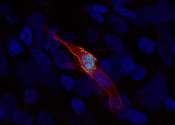Last update:
Biomedical technology news
Neuroscience
Turning brain cells on using the power of light: Researchers refine noninvasive method of bioluminescent optogenetics
University of Rochester researchers have demonstrated a noninvasive method using BL-OG, or bioluminescent optogenetics, that harnesses light to activate neurons in the brain. The ability to regulate brain activation could ...
13 hours ago
0
20
Ophthalmology
Stem cell transplants repair macular holes in primate study
Human stem cell transplants successfully repaired macular holes in a monkey model, researchers report October 3 in the journal Stem Cell Reports. After transplantation, the macular holes were closed by continuous filling ...
16 hours ago
0
34
Unlocking new regenerative pathways in iPS cell–derived epicardium for cardiac repair
Efforts to foster both intrinsic and extrinsic regenerative responses in heart failure have once again brought iPS cell technologies to the forefront, thanks to their flexibility in reconstructing tissues in vitro and enabling ...
15 hours ago
0
2

Virtual family-centered rounds help parents support their child's care
In a new study, researchers at UC Davis Children's Hospital have shown that virtual family-centered rounds are a valuable resource for families with children in the neonatal intensive care unit (NICU). The study was published ...
11 hours ago
0
0

Artificial left ventricle mimics the shape and function of the human heart
A team of biomechanical engineers at the University of New South Wales, working with a colleague from Queensland University of Technology and cardiac surgeons at St Vincent's Hospital, Sydney, has developed an artificial ...

Study hints at ways to generate new neurons in old brains
Most neurons in the human brain last a lifetime, and for good reason. Intricate, long-term information is preserved in the complex structural relationships between their synapses. To lose the neurons would be to lose that ...
Oct 2, 2024
0
55

A new injectable shows promise to prevent and treat hypoglycemia
People with diabetes take insulin to lower high blood sugar. However, if glucose levels plunge too low—from taking too much insulin or not eating enough sugar—people can experience hypoglycemia, which can lead to dizziness, ...
Oct 2, 2024
0
35

Stronger together: Miniature robots in convoy transport an endoscopic instrument for microsurgery
Miniature robots on the millimeter scale often lack the strength to transport instruments for endoscopic microsurgery through the body. Scientists at the German Cancer Research Center (DKFZ) are now combining several millimeter-sized ...
Oct 1, 2024
0
50

AI model provides deep insights into hand movement, an essential step for development of neuroprosthetics
In neuroscience and biomedical engineering, accurately modeling the complex movements of the human hand has long been a significant challenge.
Oct 1, 2024
0
21

Deep brain stimulation shows immediate improvement in arm and hand function post-brain injury, study finds
Deep brain stimulation may provide immediate improvement in arm and hand strength and function weakened by traumatic brain injury or stroke, University of Pittsburgh School of Medicine researchers report today in Nature Communications.
Oct 1, 2024
0
82

Black, white cancer patients now benefit equally from cord blood therapy
Blood cancer patients of all races who receive cord blood transplants are now living longer.
Oct 1, 2024
0
2

Patient with type 1 diabetes functionally cured using stem cell injections
A team of medical researchers affiliated with a large number of institutions in China has functionally cured a female patient with type 1 diabetes by injecting her with programmed stem cells.

New hand-held scanner generates 3D images in seconds to facilitate early diagnosis
A new hand-held scanner developed by UCL researchers can generate highly detailed 3D photoacoustic images in just seconds, paving the way for their use in a clinical setting for the first time and offering the potential for ...
Sep 30, 2024
0
112

New brain-mapping tool may be the 'START' of next-generation therapeutics
Scientists at the Salk Institute are unveiling a new brain-mapping neurotechnology called Single Transcriptome Assisted Rabies Tracing (START). The cutting-edge tool combines two advanced technologies—monosynaptic rabies ...
Sep 30, 2024
0
40

Spinal cord organoids could unlock safer treatment for pregnant women with epilepsy
University of Queensland researchers have made a significant step towards enabling women with epilepsy safer access to a common and highly effective anti-seizure medication.
Sep 30, 2024
0
15

Scientists have figured out how to see through mice—could humans be next?
Imagine being able to see right through your skin to watch your muscles or organs in action. It sounds like science fiction, but a group of scientists at Stanford University were recently able to make the skin of live mice ...
Sep 30, 2024
0
2

Neanderthoids and space brains: Stem cell researcher pushes the boundaries of neuroscience
In an interview published in Brain Medicine, Dr. Alysson Muotri—Professor in the Department of Pediatrics and Cellular and Molecular Medicine at the UC San Diego School of Medicine and director of the Sanford Stem Cell ...
Sep 30, 2024
0
0

Hydrogel with ultrasound activation enables sustained drug release
Researchers at Michigan Medicine have developed a composite hydrogel capable of achieving sustained, steady drug release using ultrasound as a trigger.
Sep 28, 2024
0
9

Exploring how melanin influences clinical oxygen measurements
Obtaining accurate clinical measurements is essential for diagnosing and treating a wide range of health conditions. Regrettably, the impact of skin type and pigmentation is not equally considered in the design and calibration ...
Sep 27, 2024
0
0

Disparities found for Non-Hispanic Black patients in hematopoietic cell transplantation use for hematologic cancers
Non-Hispanic Black patients in the United States appear to have persistent disparities in terms of hematopoietic cell transplantation (HCT) for various hematologic cancers, according to a study published online Sept. 18 in ...
Sep 27, 2024
0
0

A 'Google Earth' view of bone—with an eye toward disease prevention
Everyone knows that we can view the broad structures of our bones in the body by taking X-rays. Yet that's just scratching the surface. Science now has a host of new imaging and characterization techniques to go deeper, and ...
Sep 26, 2024
0
28

Organoids derived from gut stem cells reveal two distinct molecular subtypes of Crohn's disease
Crohn's disease—an autoimmune disorder—is characterized by chronic inflammation of the digestive tract, resulting in a slew of debilitating gastrointestinal symptoms that vary from patient to patient. Complications of ...
Sep 26, 2024
0
67

Engineering human heart tissue for scientific study
Northwestern Medicine scientists have developed a new way to measure heart contraction and electrical activity in engineered human heart tissues, according to findings published in Science Advances.
Sep 26, 2024
0
25

Microfluidic chip brings hope for sepsis prognosis and evaluation
A research team led by Associate Professor Yang Ke from the Hefei Institutes of Physical Science of the Chinese Academy of Sciences, in collaboration with the First Affiliated Hospital of Anhui Medical University, developed ...
Sep 26, 2024
0
0

Long-COVID sufferers are conserving strength with a 'hack' of their fitness tech
At the beginning of the pandemic, when people suffering from the long-term effects of COVID-19 faced more questions than answers from doctors, they began collecting data on themselves using fitness watches to better understand ...
Sep 26, 2024
0
1













































